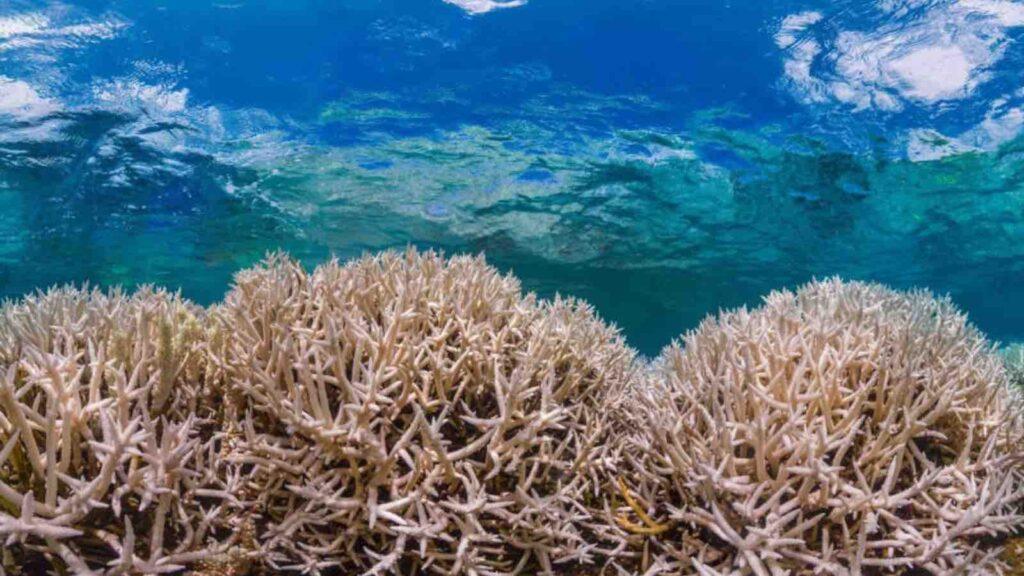The muted 2025 coral spawning bears similarity to 2017, when a subdued reproductive season followed the 2016 global bleaching crisis. “One coral genus in particular, Platygyra, known for its regular and robust spawning, showed minimal activity this year
SINGAPORE — The annual coral spawning spectacle in Singapore’s reefs passed this April with less fanfare than usual. Scientists say the subdued event, observed between April 15 and 19 at Pulau Satumu — home to Raffles Lighthouse — is not the result of oil spills, but more likely a consequence of the severe coral bleaching that struck in 2024, one of the hottest years in recorded history.
The muted mass spawning — a typically vivid, once-a-year event when corals simultaneously release eggs and sperm into the sea — raises red flags about the long-term reproductive health of Singapore’s coral reefs.
RELEVANT SUSTAINABLE GOALS


Climate Change, Not Oil Spills, Behind Subdued Spawning
In a joint statement, the National Parks Board (NParks) and researchers from the National University of Singapore (NUS) attributed the weakened spawning to the aftermath of a prolonged heatwave-induced bleaching event. The 2024 incident, driven by rising sea surface temperatures and exacerbated by El Niño, left about 44% of Singapore’s coral colonies bleached by July, with an estimated 5% mortality.
By year-end, coral recovery was underway, with bleaching levels declining to around 10–15%. But even those that survived the ordeal may have lacked the energy reserves necessary for successful reproduction.
“Corals that recovered from the bleaching in 2024 may not have had enough energy to reproduce this time,” said Dr. Karenne Tun, NParks’ group director of the National Biodiversity Centre.
The Bleaching That Set It Back
The muted 2025 coral spawning bears similarity to 2017, when a subdued reproductive season followed the 2016 global bleaching crisis. “One coral genus in particular, Platygyra, known for its regular and robust spawning, showed minimal activity this year,” added Dr. Tun.
From January 2023 to March 2025, about 84% of the world’s coral reefs experienced heat stress levels consistent with bleaching, according to the International Coral Reef Initiative. This fourth recorded global bleaching event adds urgency to mounting concerns over climate-driven oceanic change.
Coral Bleaching: A Visible Symptom of a Deeper Crisis
As sea temperatures rise, corals expel the symbiotic algae that provide them with color and nutrients. The resulting “ghost-white” appearance is a sign of stress that can impair growth, reproduction, and, in extreme cases, cause death. In Singapore’s case, reef surveys conducted in the Southern Islands — where much of the country’s remaining healthy reefs reside — provide a window into how widespread these impacts are.
Dr. Lionel Ng, research fellow at NUS’ Tropical Marine Science Institute, warned that “muted spawning after bleaching events may become an increasingly frequent reality with climate change.” He emphasized that reduced reproductive output could impact the ability of reefs to sustain biodiversity and support ecosystem functions such as fish nurseries and shoreline protection.
Coral reefs, often called the rainforests of the sea, are foundational to marine biodiversity. In Singapore’s waters, they support sea sponges, reef fish, seahorses, and other endangered marine life. Subdued coral spawning limits the chances of new colony establishment, slowing ecosystem recovery.
With oil spills ruled out as a primary cause — Pulau Satumu was untouched by leaks recorded in 2024 — scientists point squarely to thermal stress as the driving factor
“Reproductive failure has implications for habitat restoration,” Dr. Ng said, suggesting that new approaches, including the use of other benthic marine species, may be required to assist in the regeneration of degraded reefs.
A Fragile Hope: Past Recovery Shows It’s Possibles
Despite the grim outlook, experts caution against despair. Dr. Tun notes that coral spawning rebounded strongly in 2018 and 2019 after the previous bleaching setback. “We are hopeful that the corals will recover to full fecundity within the next two years if our reefs are not subjected to further thermal or other stressors,” she said.
That optimism, however, hinges on action — both local and global. Singapore’s coral resilience may depend on continued monitoring, adaptive management strategies, and climate policies that curb warming trends.
Singapore’s annual coral spawning survey — conducted by NParks, NUS, and St. John’s Island National Marine Laboratory — will remain a critical barometer of reef health. Marine scientists are also innovating new strategies to help reefs adapt, including selective breeding, larval rearing, and assisted migration.
While the skies above Singapore’s reefs appear clear, it is the temperature of the ocean — silent and unrelenting — that may determine whether these reefs can bloom again.
You may also be interested in :
Mass Coral Bleaching Threatens 84% of World’s Reefs: A Climate Crisis Unfolding




